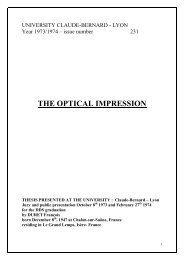english version(pg40to78) - Pr. François Duret
english version(pg40to78) - Pr. François Duret
english version(pg40to78) - Pr. François Duret
You also want an ePaper? Increase the reach of your titles
YUMPU automatically turns print PDFs into web optimized ePapers that Google loves.
F <strong>Duret</strong> and Coll. <strong>Pr</strong>incipes de fonctionnement et applications techniques de l’empreinte optique dans l’exercice de cabinet<br />
(traduction Anglaise)<br />
Page 94<br />
- respect of contact zones 2/3, 1/3… or diastemas 23<br />
- respect of cervical bump and other functional reliefs 23<br />
- respect of shape and occlusion’s aesthetics according to the<br />
chosen theory<br />
- perfect adaptation of the finishing line of the prosthesis at the<br />
base of the cutting, etc…<br />
It is evident that the whole of these data represents a limited volume 14<br />
in which the model will have to fit. For that reason, we have given the<br />
name of envelope to this limited cloning space (Fig. 30). On the other<br />
hand, this model is the personalised reconstruction of the repaired<br />
tooth. This approach mode must be compared with the one recently<br />
done by PERELMUTER and LIGER who memorised their envelope<br />
with high viscosity silicone materials (personalisation being here the<br />
memorisation of the initial shape).<br />
We will define the envelope as a limited space in which the prosthesis<br />
will be cloned. This space is identifiable since its limits are dependant<br />
not of the piece itself but of its environment. It is necessary to know as<br />
well as coding the significant zones of the prosthetic space.<br />
By supposing that this tooth exists and that it is little or not dilapidated<br />
before the cut, all we need to do is memorise the shape before the<br />
reduction according to PERELMUTER’s technique. In the opposite<br />
case, it is necessary to have a data support. The method which seems<br />
most logical consists of memorising all the teeth and adapt the<br />
corresponding tooth to the model’s envelope. The memorised tooth<br />
represents the volume data support of the model’s extrados. After<br />
having personalised it by a game of specific symmetrical comparisons,<br />
the informative shape is cloned in the space defined by the envelope.<br />
This mode enables the memorisation of few shapes without limiting<br />
them and insures the adaptation of a theoretical shape to a practical<br />
and individual space.<br />
The intrados will be the replica of the stump’s impression increased<br />
by a certain percentage corresponding to the granulometry and the<br />
mechanical needs of the luting cement. This modification can be of<br />
variable coefficient 24 (Fig. 31).<br />
Les Cahiers de <strong>Pr</strong>othèse (50) pp 73 – 110, 1985



